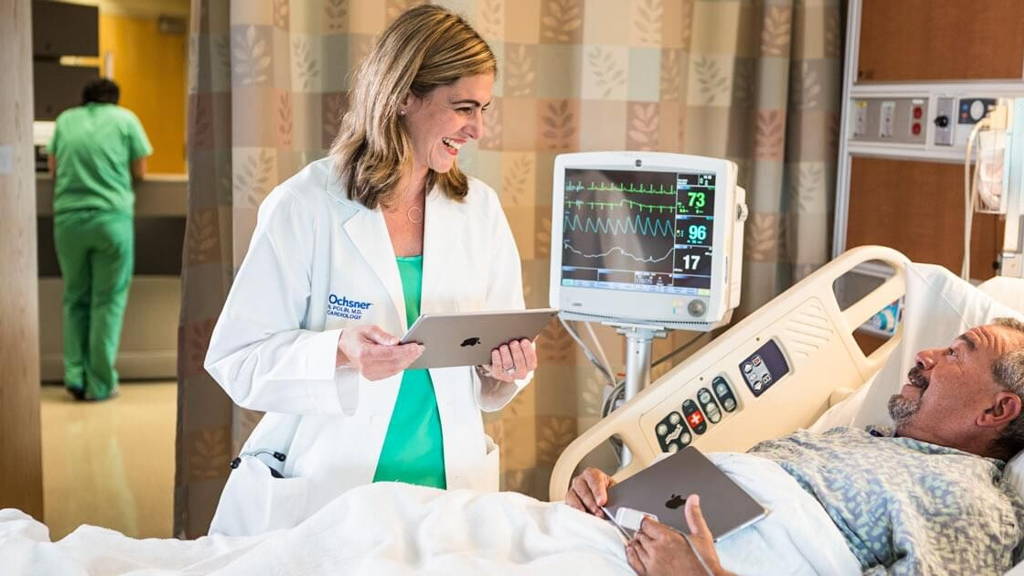The healthcare industry is an interesting one for Apple and its iPads. Not only do hospitals and health systems tend to buy devices in bulk; they also provide a way to connect with patients. iPhones and iPads have been in use in some hospitals for several years, but its only now that the company is making moves to get a tighter grip on the market. Eventually, the company wants to help patients have digital health information at their fingertips by making a shift to mobile instead of USB-sticks and CD-ROMs.
Patients, on the other hand, have adapted quickly to using mobile devices in their daily lives to track their health.
Three software services should help mobile developers and consumers to pull together disparate health information such as steps, sleep, and heart rate in one place. Healthkit should make it easier for developers to gather health data. ResearchKit helps researchers recruit participants for their studies. And CareKit is geared at helping patients with chronic conditions share data with their care team.
Cedars-Sinai in Los Angeles uses HealthKit and other iOS offerings. As of this week, patients can log in to their medical chart, click a download button, access a copy of their medical record, and port it to their Apple health app on a smartphone.
Ochsner Medical Center in New Orleans installed an “O Bar” store modelled after Apple retail stores. The “O Bar” sells products recommended by doctors including iPads, activity monitors, wireless scales, and blood pressure monitors. “Genius Bar” staff are also available to demonstrate how to use these devices.
One of the solutions Apple offers for these concerns, is making an enterprise solutions architect available by phone to reassure IT buyers about security and privacy. To secure a top-notch wireless connectivity In the past few years, Apple has enhanced security and made feature updates so that the most critical apps are prioritized on the wireless network.
The biggest issue however, will be making sure that patients are comfortable using Apple devices. After all, the world does not only consist of Apple users, either because they don’t have access to them, or because they prefer Android or Windows. It will take a long time before the saying ‘An apple a day, keeps the doctor away’ will be about the Apple with a capital A.
Cultural resistance
At the moment, only a select group of health care providers has embraced the adaptation of mobile devices in health care. Medical professionals tend to shy away from the transition; instead preferring clipboards and pagers. It wasn’t until recently that most physicians started to change the way they work. This isn’t strange, since most humans aren’t fond of change, especially ones that cause as much disruption as the introduction of mobile health. On top of that, most hospitals are still tied to on-premises enterprise software.Patients, on the other hand, have adapted quickly to using mobile devices in their daily lives to track their health.
Three software services
The transition has inspired Apple to become a platform. Instead of making their own apps, they tap into the pool of developers who were already developing apps for health care. They connect these developers with hospital executives and their developer relations team.Three software services should help mobile developers and consumers to pull together disparate health information such as steps, sleep, and heart rate in one place. Healthkit should make it easier for developers to gather health data. ResearchKit helps researchers recruit participants for their studies. And CareKit is geared at helping patients with chronic conditions share data with their care team.
Already in use
The software services and apps Apple provides are already in use in several hospitals. Colorado-based Parkview Medical Center uses the Patient Safe Solutions app to help nurses manage patients’ medications at their bedside.Cedars-Sinai in Los Angeles uses HealthKit and other iOS offerings. As of this week, patients can log in to their medical chart, click a download button, access a copy of their medical record, and port it to their Apple health app on a smartphone.
Ochsner Medical Center in New Orleans installed an “O Bar” store modelled after Apple retail stores. The “O Bar” sells products recommended by doctors including iPads, activity monitors, wireless scales, and blood pressure monitors. “Genius Bar” staff are also available to demonstrate how to use these devices.
Three major concerns
However, no transition comes without its concerns. Three major issues with iOS that were causing some concern were: order fulfillment in device life-cycle management (meaning reassuring these customers they wouldn’t need to order new devices in less than three years), security, and wireless connectivity.One of the solutions Apple offers for these concerns, is making an enterprise solutions architect available by phone to reassure IT buyers about security and privacy. To secure a top-notch wireless connectivity In the past few years, Apple has enhanced security and made feature updates so that the most critical apps are prioritized on the wireless network.
The biggest issue however, will be making sure that patients are comfortable using Apple devices. After all, the world does not only consist of Apple users, either because they don’t have access to them, or because they prefer Android or Windows. It will take a long time before the saying ‘An apple a day, keeps the doctor away’ will be about the Apple with a capital A.






